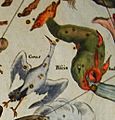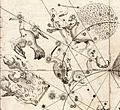Grus (constellation) facts for kids
| Constellation | |

List of stars in Grus
|
|
| Abbreviation | Gru |
|---|---|
| Genitive | Gruis |
| Pronunciation | or colloquially genitive |
| Symbolism | the crane |
| Right ascension | 21h 27.4m to 23h 27.1m |
| Declination | −36.31° to −56.39° |
| Quadrant | SQ4 |
| Area | 366 sq. deg. (45th) |
| Main stars | 7 |
| Bayer/Flamsteed stars |
28 |
| Stars with planets | 6 |
| Stars brighter than 3.00m | 3 |
| Stars within 10.00 pc (32.62 ly) | 1 |
| Brightest star | α Gru (Alnair) (1.73m) |
| Messier objects | 0 |
| Meteor showers | none |
| Bordering constellations |
Piscis Austrinus Microscopium Indus Tucana Phoenix Sculptor |
| Visible at latitudes between +34° and −90°. Best visible at 21:00 (9 p.m.) during the month of October. |
|
Grus is a constellation found in the southern part of the night sky. It is often called "The Crane" because its stars look like the shape of a crane bird. This constellation is one of the newer ones, created in the late 1500s.
Grus is a great constellation to look for if you live in the Southern Hemisphere. It is also visible from some parts of the Northern Hemisphere, especially closer to the equator.
Contents
Grus: The Crane Constellation
Grus is a beautiful constellation that represents a crane, a type of large bird. It is located in the southern sky, near other bird-like constellations. These include the Toucan (Tucana) and the Phoenix.
This constellation is not one of the oldest ones. Ancient civilizations like the Greeks and Romans did not know about Grus. It was first mapped by Dutch explorers in the late 16th century.
What is a Constellation?
A constellation is a group of stars that form an imaginary shape or pattern in the night sky. People have used these patterns for thousands of years. They helped with navigation, telling time, and creating stories.
The stars in a constellation are usually very far apart in space. They only appear close together from our view on Earth. Grus is one of 88 official constellations recognized today.
Finding Grus in the Night Sky
Grus is best seen during the month of October. It is located in the fourth quadrant of the southern sky. This means it is in the southeast part of the sky for observers in the Southern Hemisphere.
To find Grus, you can look for the bright star Fomalhaut in the constellation Piscis Austrinus. Grus is located just south of Fomalhaut. It borders several other constellations, including Microscopium and Indus.
Brightest Stars in Grus
Grus has several interesting stars. The brightest star in Grus is called Alnair. Its official name is Alpha Gruis. Alnair means "the bright one" in Arabic.
Alnair is a very hot and bright star. It shines with a bluish-white light. It is about 101 light-years away from Earth. Another notable star in Grus is Beta Gruis.
There is also a star system in Grus called Gliese 832. This star is a red dwarf. It has at least one planet orbiting it. This planet is called Gliese 832 c. Scientists think it might be a "super-Earth."
The Story Behind Grus
Grus was first drawn on a star map by Petrus Plancius. He was a Dutch astronomer and cartographer. He used observations from Dutch explorers Pieter Dirkszoon Keyser and Frederick de Houtman. They traveled to the East Indies in the late 1590s.
These explorers mapped many new stars in the southern sky. They created several new constellations. Many of these constellations represent animals. These animals were often seen during their voyages. The crane was one of these animals.
Before Grus was recognized, its stars were sometimes part of the constellation Piscis Austrinus. This was the "Southern Fish." But Plancius decided to make it a separate constellation. He named it Grus, after the crane.
Images for kids
-
The constellations Grus and Piscis Austrinus, which once formed a single constellation, as depicted in Atlas Coelestis by Johann Doppelmayr, ca. 1742
-
The "southern birds," as depicted in Johann Bayer's Uranometria
See also
In Spanish: Grus (constelación) para niños



